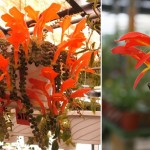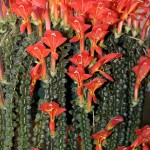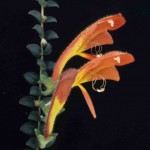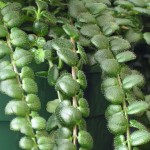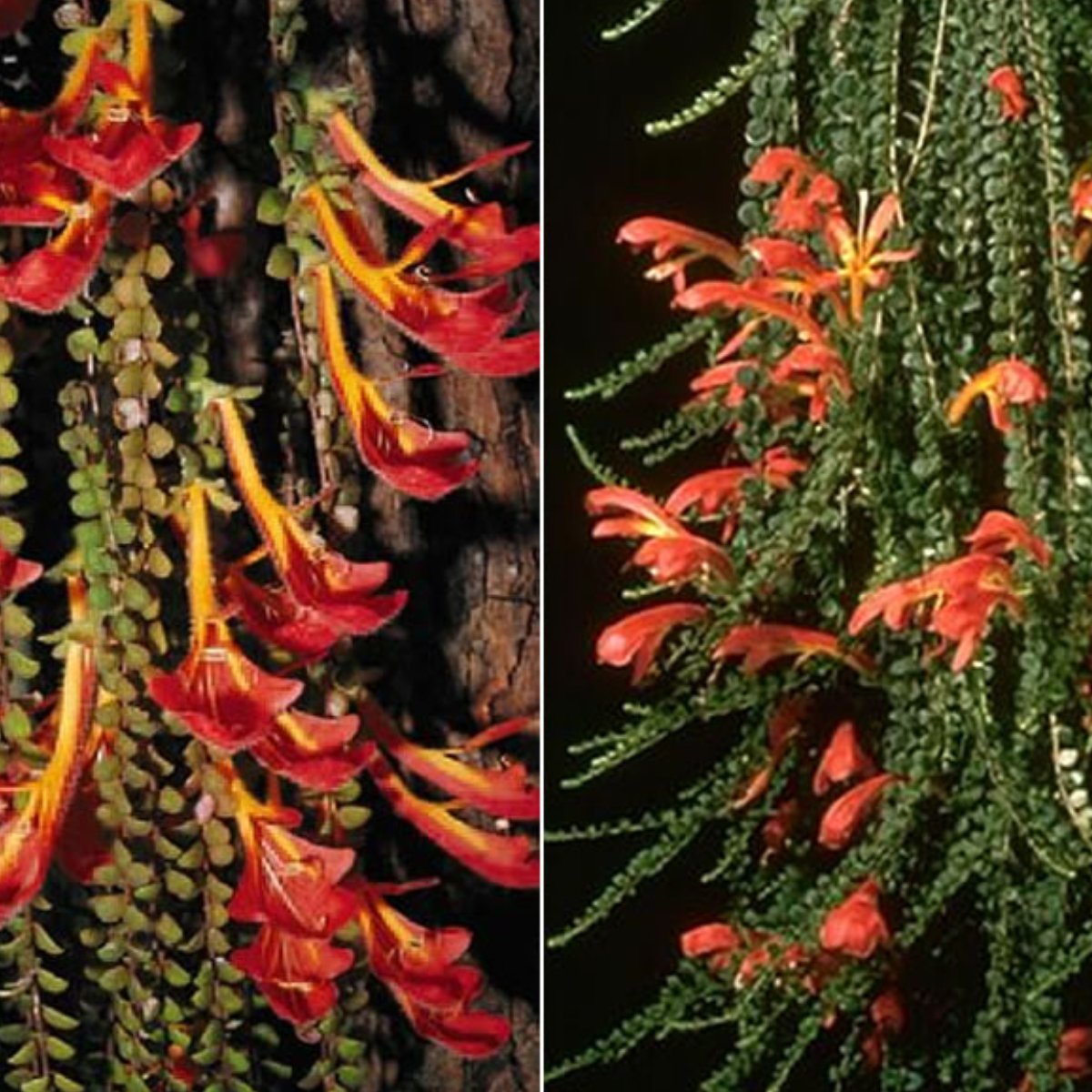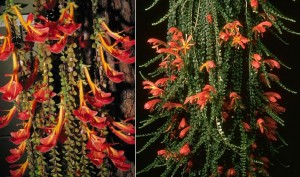Family: Gesneriaceae
Distribution and habitat: Columnea microphylla are tropical plants from the cloud forests of Costa Rica. In wild, they grow as epiphytic plants where they straddle rotten tree trunks or are tucked in the crevices of boulders, perching anywhere that vegetable debris has accumulated. In their natural habitat the roots are supplied with continual moisture and excellent drainage assures they never stand in water. These plants come from higher altitude where they have developed strong seasonal habits, responding to a cool conditions period (unlike most of the rest of the species in the genus) in order to flower abundantly.
Description: Columnea microphylla is a spectacular spring flowering plant with thin, trailing and branching stems, up to 2.5m (8 feet) long which are densely covered with brownish red hairs. The stems carry nearly overlapping pairs of equal size, almost round, dark green leaves up to 1.5cm (0.5 inch) in diameter; these too are densely covered with reddish hairs. Flowers, carried singly on tiny stalks, bear hairy calyxes, which are green tinged with red. Flower corollas are bright scarlet with yellow throat and are up to 9cm (3.5 inch) long. The flowers are produced from leaf axils, with a five-lobed calyx and striking in shape. Each tubular corolla flares into five differently shaped lobes. The two upper lobes are joined together to form a down-curving hood above the others. As the flower opens, its stamens can be seen just under the outer end of the hood and later the stigma also projects beyond the hood. It is the shape of the colourful open flowers that given Columnea microphylla the common name of golden-fish plant, for from some angles the flowers resembles a head-on view of a fish. Up to 100 flowers may bloom simultaneously on one large plant and each flower can last for four weeks. The flower is followed by an attractive, often white berry cupped within the calyx.
This plant looks best when it is allowed to trail down from a hanging basket. It is important to prune this plant after flowering
Houseplant care: Columnea microphylla are easy to grow under indoor or greenhouse conditions and require bright light, good air circulation and a well-drained growing medium that is allowed to dry out slightly between waterings.
Pruning and propagating is possible in any season. Prune back old stems severely after the flowering season to encourage new growth.
Light: Columnea microphylla like bright light without direct sunlight. These plants need the short day-length of winter in order to produce flowers. If such plants are being grown in artificial light, it should be adjusted accordingly.
These plants are one of the few groups of flowering plants which can be grown in an eastern or northern exposure and thrive. Fluorescent lights are also suitable, with no more than 12 to 14 hours of artificial light daily.
The baskets of Columnea microphylla plants may be grown outdoors in shaded areas during the summer. Place them in bright places but in the shade, always away from direct sunlight and drafts dry or cold.
Temperature: Normally warm room temperatures 18-30C (64-86F) are right for Columnea microphylla plants during the active growing period. These plants set buds in autumn. In the native lands, they are subjected to substantially lowered nighttime temperatures at this time of year, often a 5.5C (10F) drop from day to evening. In cultivation the plants react favorably when given an autumnal diversity in climate.During the winter they need to be somewhat cooler 13-18C (55-64F) to promote flowering in spring.
In the rain forests where Columnea microphylla plants dwell, humidity remains constantly high. These plants require high humidity - 50% humidity - at all times. Stand pots on trays of moistened pebbles and mist spray plants in hanging baskets once a day. Water for spraying should be at room temperature. If cold water is sprayed, it can result in unattractive brown leaf stains. A humidifier remains the most effective means of increasing moisture.
Watering: Although they need high humidity around leaves, Columnea microphylla cannot tolerate wet roots which cause the stem to rot. During the active growing it is best to water sparingly, just enough to make the entire mixture barely moist and let the top third of the potting mixture dry out between waterings. During the rest period, water the plant just enough to keep the potting mixture from completely drying out. Use water at room temperature to avoid brown spots on leaves. These plants have delicate foliage which can be easily damaged by water.
Feeding: While Columnea microphylla is actively growing, give it applications of a high phosphate liquid fertiliser, about one quarter the recommended strength at every watering.
Potting and repotting: TheColumnea microphylla cascading habit lends itself as a hanging plant. The most commonly used container is a clay pan, sinceColumnea microphylla roots grow horizontally rather than vertically. Keep them tightly potted to encourage flowering.
Because Columnea microphylla are epiphytic plants in the wild, they may be grown simply in coarse sphagnum moss or, if preferred, use a loosely packed equal parts potting mixture of peat moss, perlite and verniculite. Shallow pots or pans about 10cm (4 inch) in diameter or smaller, shallow baskets are best for growing Columnea microphylla.
When the roots of a plant fill its container, move it into a container one size larger or, alternatively, trim about one-third off the bottom of the root ball with a sharp knife and repot the plant on same size container, adding fresh potting mixture as required. Best time to repot these plants is just as the growth period begins.
Propagation: The best time to propagate Columnea microphylla is when repotting. Insert a tip cutting 7-10cm (2.5-4 inch) long in a 8cm (3 inch) pot of moistened verniculite and keep the pot at normal room temperature in a bright filtered light, watering only often enough to keep the verniculite barely moist. Rooting should occur in about four weeks after which the new plant should be transferred to an 8cm (3 inch) pot of the standard potting mixture for adult plants and treat as a mature columnea. For a really good display, it is recommended to plant three or four of the rooted cuttings in a single 25cm (10 inch) hanging basket.
Columnea microphylla can also be grown from seed. When the seed is soft and ripe, collect the seed and sow by spinkling lightly on the surface of fine soil. Germination is in approximately two weeks.
Problems:
Leaf drop causing the stems to look bare.
Treatment: Ensure that the plant has plenty of humidity and is mist-sprayed frequently. The same symptom can indicate draughts, too low a temperature, over- or under-watering and each of these must be checked.
Droplets of cold water on leaves will often cause mottling, shriveling and sometimes denuding, especially if the plant is subjected to bright light.
Treatment: Use water at room temperature to water the plants or to spray mist them. Humidifiers are a better alternative to maintain high humidity than to mist the plants.
Occasionally mealybugs infest the plants.
Treatment: These pests can be easily eradicated with a cotton swab dipped in rubbing alcohol.
Cyclamen mite is a troublesome pest on Columnea microphylla plants, its presence is detected by malformed and twisted new growth.
Treatment: An application of kelthane destroys these insects before they deface the plants.
The Columnea microphylla is prone to be attracted by aphids. These insects suck the sap and make the brittle leaves. They tend to curl and may be covered with scabs.
Treatment: Spray a systemic insecticide and repeat this treatment a month later.
Fine webbing under leaves betray an attack of spider mites favored by air too hot and too dry.
Treatment: Spray with a suitable acaricide or systemic insecticide. Increase the humidity around the plant.
Stems root in the event of excess water or cold temperature.
Treatment: Find a warmer location and dry the plant.
The plant will benefit fromperiodical soil oxygenating to prevent the occurrence of fungi. Use a small fork to loose the soil.
The stems are thin and elongated too . The plant is lack of light.
Treatment: Place the plant in bright light protected from direct sun light.
The leaves shrivel on themselves. The soil is too dry.
Treatment: Water immediately and especially more regularly thereafter.
The leaves are stunted growth is puny and the plant does not flower. The Columnea microphylla could be suffering from heat and lack of ventilation.
Treatment: Find a cooler and better ventilated place.
Growth is sickly, small leaves and very poor flowering can be caused by lack of fertiliser.
Treatment: Fertilise the plant as recommended.
Note: Columnea species are commonly confused with another member of the Gesneriad Family, Aeschynanthus species (Lipstick Plant). These plants bear many similarities including shiny, paired leaves and brightly colored tubular flowers.
Uses and display:Columnea microphylla stands out in the world of indoor hanging plants spectacle due to their masses of flowers orange-red overflowing hanging baskets in the spring and summer and fish resembling 'goldfish', name which is also popularly used to refer to this beautiful plant genus. They are stunning in a hanging basket when in bloom. Also can be used as table top plant, especially when planted in high pots. This plant is ideal for apartments with limited space to spare for pots and plants.
SUMMARY:
CHARACTERISTICS:
Foliage green
Features flowers
Shape climbing and trailing
Height: 2.5m (8 feet)
PROPER CARE:
Watering in rest period sparingly
Watering in active growth period sparingly
Light bight
Temperature in rest period min 13C max 18C (55-64F)
Temperature in active growth period min 18C max 30C (64-86F)
Humidity high
Hardiness zone: 11
